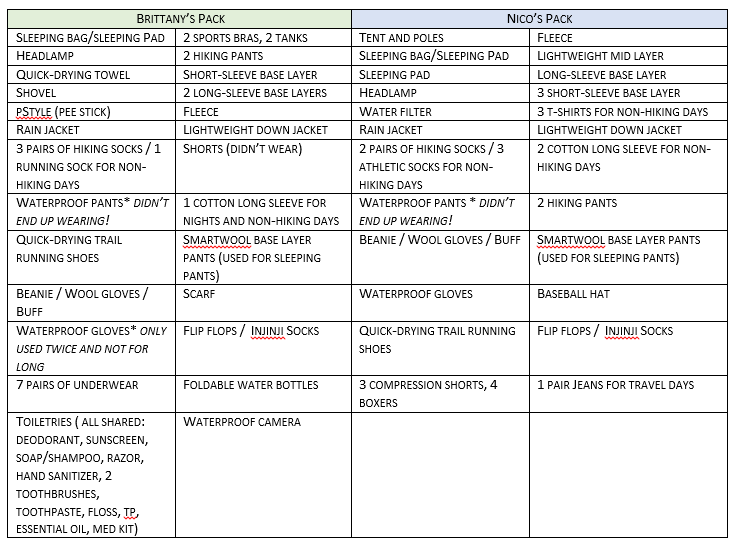Whether it’s a quick weekend getaway or a multi-week trip, our family and friends are always amazed at how light we pack. We usually manage to take a single carry-on with all of our stuff for multi-day, even international, trips. For skiing or diving, we usually have a large checked bag in addition to the carry-on. Sometimes we supplement with a backpack. Needless to say, we have gotten packing lightly for our travel adventures down to a science.
Our trip to Chile/Torres del Paine offered a new packing challenge. We would be backpacking for 4 nights and 5 days in the park, spend a couple days in town before and after the trek, and explore Panama Ciry on a 10 hour layover en-route (we didn’t want to pass up the opportunity to explore the city – even in the hot and humid weather). Even though we were bringing our own tent to camp, 2 of the 4 Refugios we booked required purchasing full board – breakfast, lunch and dinner. We debated between bringing our cooking gear for the other nights on the trail, or just purchasing full board at the other 2 Refugios. Had we needed to bring our stove and cooking gear, we would have also needed to bring an additional bag and left it at the hotel in Puerto Natales with items not needed during the trek. However, we would have ended up filling the carry-on with items we didn’t really need just to make it full enough to justify bringing. So we opted for the minimalist approach taking only our 40 liter backpacks and a recently acquired waist pack (also known as a “fanny” or fanny pack) for small items.
For a bit of context, a 40 liter pack is good for 1-3 night backpacking trips with a fairly minimal approach. Subsequently, as you can imagine, a 40 liter pack doesn’t leave a lot of space to work with for a 10 day trip which includes a 4 night backpacking adventure. As such, our packs were pretty full and didn’t allow for extra room to fit souvenirs (we tend to think most souvenirs are unnecessary so this wasn’t a problem) or ‘nice-to-haves’ like an extra shirt or shoes other than our hiking shoes. While they are both 40 liters, Nico’s pack tends to hold a bit more, including the tent.
Each of our packs included the following:



Overall we were happy with out packing strategy, and we could even have left a few things behind!
Tips:
- We used compression stuff sacks to compact the clothes in our packs. (We even started taking these on other weekend trips to compress several sets of underwear to take up almost no space.)
- You can get away with one set of clothes for hiking and a second set for hanging out at night. Let the hiking clothes dry at night. Stuff them inside your sleeping bag if they’re particularly wet, and they’ll be dry in the morning.
- Lots of blogs recommended hiking boots for Patagonia, but we were happy with our quick-drying trail running shoes. Even when the shoes got wet from trekking through a swamp, they were dry within a few hours.
- Get Buffs for covering head and face when the wind picks up or a little extra warmth is needed.
- We enjoyed retiring to our own tent at night vs. staying in a bunk room. We’re both somewhat light sleepers and enjoyed having some privacy.
- Renting trekking poles for the descents was definitely worth it. They were also useful for river and muck crossings. Note that you’re not allowed to bring your own poles in the carry on so we rented them on arrival.
- We carried foldable water bottles for quick access / storage and ease of refilling in streams.
- You generate quite a bit of body heat while hiking, so don’t bother bringing waterproof pants or excessive layers. Even though we had 4 layers (baselayer, mid-layer, down jacket, rain jacket), we usually only wore 2 with temperatures in the 40’s. This may not work if you expect to be outside in the evening / won’t have access to lodges.
Would you opt for the full-board to go more minimal?

👏🏼awesome!